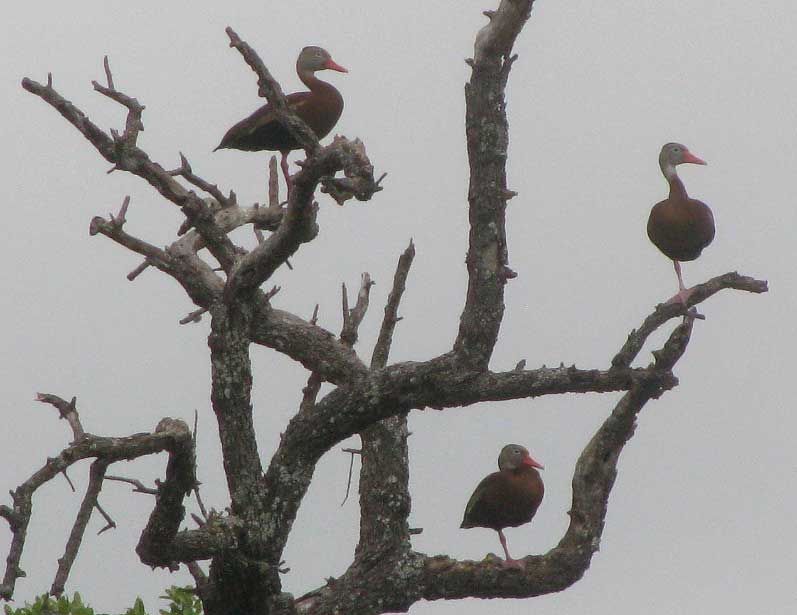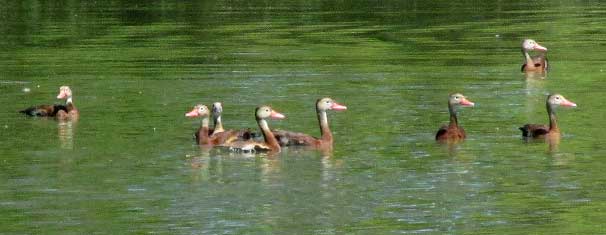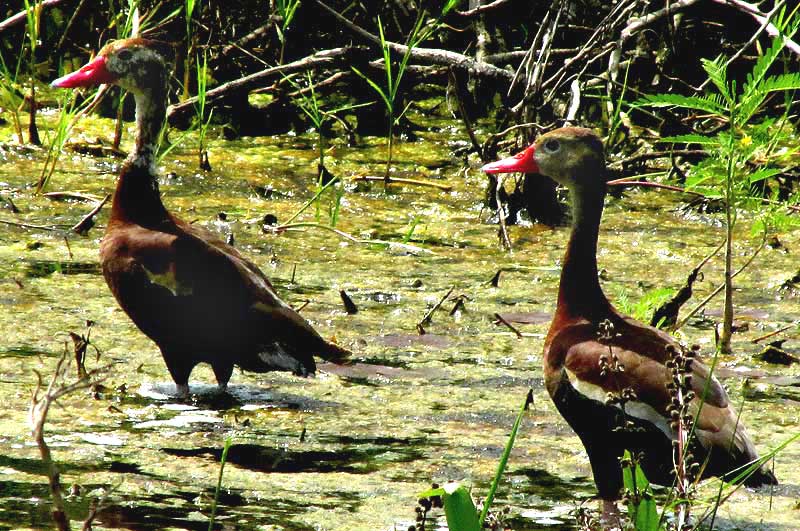Excerpts from Jim Conrad's
Naturalist Newsletter

from the April 20, 2014 Newsletter issued from the Frio Canyon Nature Education Center in the valley of the Dry Frio River in northern Uvalde County, southwestern Texas, on the southern border of the Edwards Plateau; elevation ~1750m (~5750 ft); N29.62°, W99.86°; USA
WHISTLING-DUCKS
At Cooks Slough Sanctuary and Nature Park on Uvalde's south side a resting spot next to a pond was called Whistling Duck Overlook and I had to ask my birding friend Jarvis what a whistling duck was. He said that that's what field guides have begun calling what I learned to name tree ducks -- ducks of the genus Dendrocygna. Before long a few whistling ducks with their black underparts and large, white wing streaks turned up out on the waters, mixed with many Northern Shovelers. Also, we came upon the pretty gathering shown above.
Those are Black-bellied Whistling-ducks, DENDROCYGNA AUTUMNALIS, which surprises me because the distribution map in my old field guide shows this tropical bird as present in the US only in the southernmost tip of Texas and thus not this far north. But Jarvis said that for some years the species has been expanding its distribution northward at a fairly fast rate. Now I see that new distribution maps show Black-bellies as summer breeders as far up the Mississippi River as Memphis, Tennessee, and as permanent residents in Florida, Louisiana and much of eastern and southern Texas. In tropical America they occur as far south as northern Argentina.
Cornell's "All About Birds" website explains the Black-bellied Whistling-duck's expansion northward in terms of the ducks' adapting easily to human-altered habitats. They feed on waste grain in agricultural fields, and often at night forage along the banks of shallow, man-made ponds, even those in golf courses, city parks, and sometimes they even turn up in schoolyards. As they fly between feeding areas and roosting sites, instead of quacking they emit distinctive, high-pitched whistles. As in our picture, they tend to perch in trees over water. They nest in cavities, including nest boxes.
It's gratifying to see native birds adapting to human disruptions, especially when the species is as handsome as this one.
from the August 31, 2014 Newsletter issued from the Frio Canyon Nature Education Center in the valley of the Dry Frio River in northern Uvalde County, southwestern Texas, on the southern border of the Edwards Plateau; elevation ~1750m (~5750 ft); N29.62°, W99.86°; USA
WHISTLING-DUCKS IN LATE SUMMER
Though last spring numerous ducks could be seen on the ponds at Cook's Slough Nature Park on Uvalde's south side, during the summer mostly they disappeared, but now they're drifting back again. This week, the most conspicuous are the Black-bellied Whistling-ducks, some of which are shown below:

These individuals look like freshly minted adults. Juveniles possess dark gray bills but these have the adults' orange ones, though not brightly so. Also these birds' breasts are rusty brown like the adults', not grayish like juveniles', but the rustiness isn't as vibrant as on a fully mature adult.
Mostly this flock paddled around the pond's surface always keeping an eye on me, though I was a good distance away. If the main flock went behind the island, one bird always remained in the center of an opening where he could see me, never leaving his post. Whistling ducks strike me as particularly smart and wary, which -- along with global warming -- may account for the rapid expansion of the birds' distribution area northward.
Several times I witnessed seemingly spontaneous outbreaks of frenetic splashing and calling, lasting for just a few seconds. The sounds made were less whistles than squeals -- strange sounds for ducks to be making. They seemed to enjoy these occasional eruptions of apparent craziness, and I did, too.
from the September 28, 2014 Newsletter issued from the Frio Canyon Nature Education Center in the valley of the Dry Frio River in northern Uvalde County, southwestern Texas, on the southern border of the Edwards Plateau; elevation ~1750m (~5750 ft); N29.62°, W99.86°; USA
WHISTLING DUCKS DOING NOTHING
Across Whistling Duck Lagoon at Cook's Slough Nature Park on Uvalde's south side, several Black-bellied Whistling Ducks stood on a submerged log not far from the water's edge, looking as if they stood atop the water, as seen below:

I wasn't nearly as close to the ducks as that picture suggests, nor do I have a powerful telephoto lens. I stabilized the camera on a bench in a shelter across the lagoon from the ducks, took a shot at very high resolution, and later greatly enlarged a tiny part of the picture, using PhotoShop. I hadn't even known what species they were until I saw the picture on my laptop.
I watched these ducks for about half an hour thinking they might do something interesting, but all they did is what you see, just stand there with one eye pointed at me.
But, that was kind of interesting in itself. For, Black-bellied Whistling Ducks are known to spend a good deal of time "doing nothing." They're reported as spending whole days in flooded rice fields and golf courses near rivers apparently just looking around, or at one another. I used to think that tropical America's big iguanas spent their days "doing nothing," but later I learned that what they're really doing is helping bacteria in their guts break down the large amounts of vegetative material they eat, by keeping their bodies warm as they bask in the sun. Black-bellied Whistling Ducks mostly eat plant material, too, though also aquatic invertebrates and arthropods when they can, so maybe our ducks were standing there doing their best to encourage good digestion.
from the July 12, 2015 Newsletter issued from Río Lagartos, on the north-central coast of Yucatán, MÉXICO
YOUNG WHISTLING DUCKS IN MEXICO
When I arrived at Río Lagartos I was told that Black-bellied Whistling-ducks were rarely seen during the winter dry season, but as soon as the rainy season arrives they begin appearing, and the rainier it gets, the more Black-bellied Whistling-ducks we have. That seems to be exactly the case. And that surprises me because the species is considered a permanent resident here. Maybe it's a simple case of the ducks not wanting to stay around and compete with all the Blue-winged Teal and other northern duck species that overwinter here.
Whatever the case, nowadays they're commonly seen here, both on mudflats out in the estuary and inland in marshes and saltponds. You can see two in an alga-covered pond below.

These are young ducks, as indicated by their blotchy faces. Adult faces are all gray, with a conspicuous white eye-ring. Juveniles display all-brownish heads, so these ducks' splotchy condition is a transition state from brown to gray.